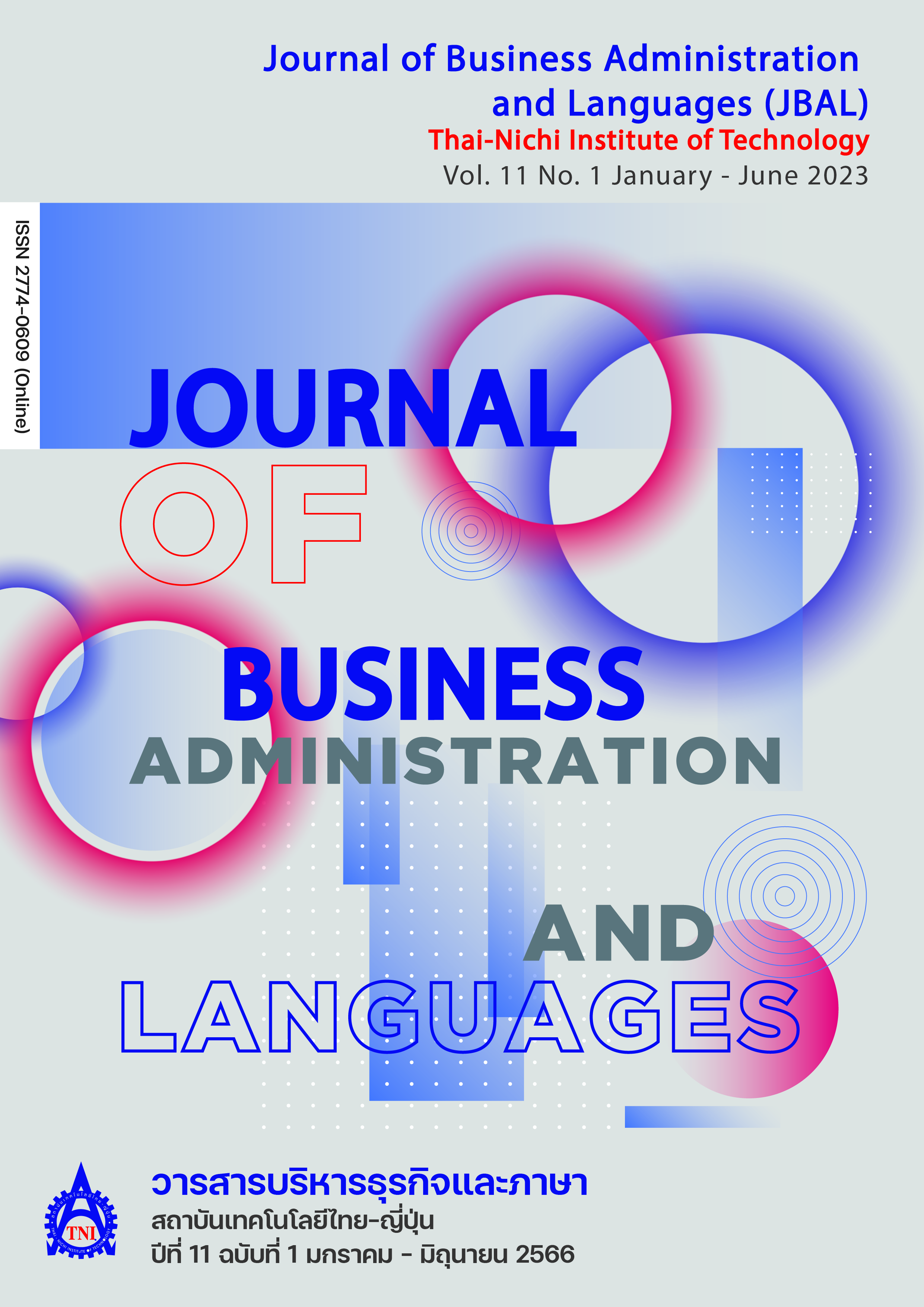An Analytical Study of Head in Thai Language
Main Article Content
Abstract
Objective to study of This research article “An Analytical Study of Head in Thai Language” is the structure and meaning of the word “Head” by gather information of 400 words from Thai national corpus randomly and only select the word “Head” as the main word, specific names and idioms are not included. 348 words has been collected, researcher choose to analyze the meaning of the word “Head” by the appearance of the word with other words then take the result to analyze the concept of how to use the word “Head”. The study shown that the word “Head” could be classified into 5 structural categories 1) stand-alone 2) head + noun 3) head + verb 4) head + adjective 5) preposition + head and found that “Head” can be used in context that have 6 different meanings 1) organ that on top of living things 2) components of the origin of thing 3) beginning 4) idea and intelligence 5) people and 6) important thing.
Article Details

This work is licensed under a Creative Commons Attribution-NonCommercial-NoDerivatives 4.0 International License.
Article Accepting Policy
The editorial board of Thai-Nichi Institute of Technology is pleased to receive articles from lecturers and experts in the fields of business administration, languages, engineering and technology written in Thai or English. The academic work submitted for publication must not be published in any other publication before and must not be under consideration of other journal submissions. Therefore, those interested in participating in the dissemination of work and knowledge can submit their article to the editorial board for further submission to the screening committee to consider publishing in the journal. The articles that can be published include solely research articles. Interested persons can prepare their articles by reviewing recommendations for article authors.
Copyright infringement is solely the responsibility of the author(s) of the article. Articles that have been published must be screened and reviewed for quality from qualified experts approved by the editorial board.
The text that appears within each article published in this research journal is a personal opinion of each author, nothing related to Thai-Nichi Institute of Technology, and other faculty members in the institution in any way. Responsibilities and accuracy for the content of each article are owned by each author. If there is any mistake, each author will be responsible for his/her own article(s).
The editorial board reserves the right not to bring any content, views or comments of articles in the Journal of Thai-Nichi Institute of Technology to publish before receiving permission from the authorized author(s) in writing. The published work is the copyright of the Journal of Thai-Nichi Institute of Technology.
References
Benyatip Suphakalin. (2018). Conceptual metaphors in Chinese and Thai languages: Words of body parts (in Thai). Journal of Language, Religion and Culture, 7(1), 184–211.
Chulalongkorn University. (2012). TNC: Thai National Corpus (3rd ed.). Retrieved from http://www.arts.chula.ac.th/~ling/tnc3/
Gan, Y., & Mathawee Yuttapongtada. (2015a). Metaphorical meaning of the word “Head” which is used as a component of the compound words in Thai and Chinese (in Thai). (Master’s thesis). Bangkok, Thailand: Kasetsart University.
Gan, Y., & Mathawee Yuttapongtada. (2015b). Metaphorical meaning of the word 'head' which is used as a component of the compound words in Thai and Chinese (in Thai). Proceedings of 53rd Kasetsart University Annual Conference: Education, Economics and Business Administration, Humanities and Social Sciences (pp. 852–859). Bangkok, Thailand: Kasetsart University.
Nuntana Wongthai. (2019). Cognitive Semantics (in Thai). Bangkok, Thailand: WORK ALL PRINT.
Pattra Pichetsilpa. (2013). The Semantic concepts of the word “XIN” in Chinese and the word /CAJ/ in Thai: A cognitive semantic study (in Thai). (Doctor’s dissertation). Retrieved from http://cuir.car.chula.ac.th/bitstream/123456789/52071/1/pattra_pic.pdf
Suphachai Tawichai. (2013). Meaning extension of the word “Lang (Back)” in Thai (in Thai). The 9th Mahasarakham University Research Conference (pp. 24–41). Retrieved from https://doi.nrct.go.th/ListDoi/Download/102329/bbc58730fa837f16c86c8506b22a9a28?Resolve_DOI=10.14456/humsu.2013.114
Suphachai Tawichai. (2014). Spatial concepts in Thai: A case study of /lăn/ in the Pantip.com website (in Thai). Journal of Humanities and Social Sciences, 6(1), 131–148.
Uthumporn Mechareon. (1999). A study of the metaphorical meaning of body part terms in Thai (in Thai). (Master’s thesis). Retrieved from http://digital.library.tu.ac.th/tu_dc/frontend/Info/item/dc:117626
Vichin Panupong. (1988). Grammar Structure: Sentences and Phrases. Handout for teaching Thai language courses 3 units 7-15 (in Thai). (pp. 95–119). Nonthaburi, Thailand: Sukhothai Thammathirat Open University.
Wanna Chinvigai. (2003). A comparative study of face-related figurative languages in Thai and Japanese (in Thai). (Master’s thesis). Retrieved from https://digital.library.tu.ac.th/tu_dc/frontend/Info/item/dc:115802


